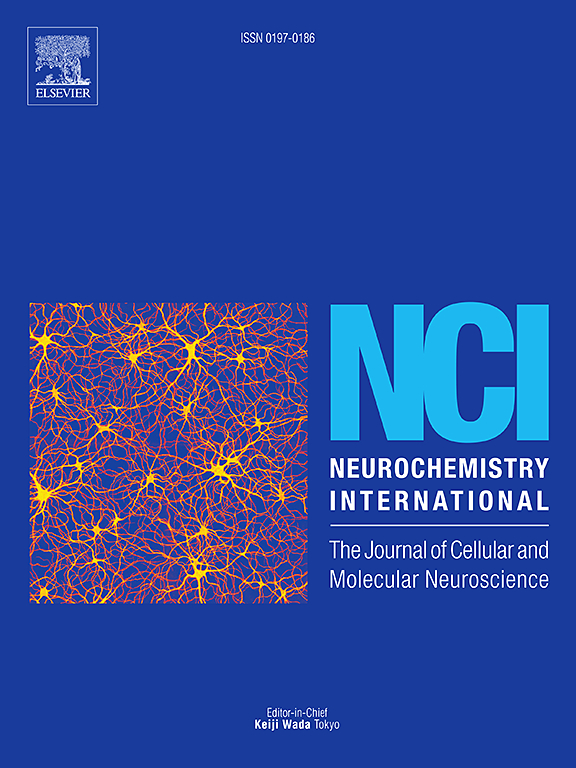衰老相关的VGVAPG六肽对蛋白质停滞和自噬的破坏——体外人细胞神经元模型中潜在的新型弹性蛋白诱导的神经退行性途径的初步见解
IF 4
3区 医学
Q2 BIOCHEMISTRY & MOLECULAR BIOLOGY
引用次数: 0
摘要
六肽Val-Gly-Val-Ala-Pro-Gly (VGVAPG)是弹性蛋白降解最容易释放的产物,这一过程与衰老密切相关。最近的研究表明,该肽能够上调Sirtuin 2 (SIRT2) mRNA和蛋白的表达。HRD1连接酶(syno小提琴1)与SIRT2降解之间的相关性此前已在文献中报道。本研究旨在探讨vgvapg诱导的HRD1与SIRT2相互作用对体外分化的SH-SY5Y细胞(神经元简化模型)自噬的影响。结果显示,VGVAPG降低HRD1 mRNA和蛋白表达,同时与SIRT2过表达相关。进一步分析显示SEL1L蛋白水平降低,p97/VCP蛋白表达增加。此外,IRE1α磷酸化的增强表明,在测试的细胞模型中,内质网应激的诱导不影响mTOR。还注意到蛋白酶体活性降低和泛素积累。这一现象触发了vgvapg诱导的自噬,自噬相关蛋白ATG16L1、ATG5、ATG18和FIP200的表达增加。然而,自噬被抑制可能是vgvapg诱导的ERK1/2磷酸化的结果。这些发现表明,衰老相关的六肽VGVAPG下调SEL1L-HRD1复合物的功能,导致SIRT2积累和ERAD和UPS导致的内质网应激。这个级联,反过来,激活自噬作为一种替代的清除途径,旨在恢复蛋白质平衡;然而,这个过程变得失调,导致持续的内质网应激。考虑到自噬损伤与衰老相关的神经退行性疾病之间的良好相关性,这种双重效应可能在神经生物学中具有重要意义。本文章由计算机程序翻译,如有差异,请以英文原文为准。

Proteostasis and autophagy disruption by the aging-related VGVAPG hexapeptide - preliminary insights into a potential novel elastin-induced neurodegeneration pathway in an in vitro human cellular neuron model
The hexapeptide Val-Gly-Val-Ala-Pro-Gly (VGVAPG) is the most readily released product of elastin degradation, a process closely associated with aging. Recent studies have demonstrated the ability of this peptide to upregulate Sirtuin 2 (SIRT2) mRNA and protein expression. The correlation between HRD1 ligase (Synoviolin 1) and the degradation of SIRT2 has been previously reported in the literature. This study aimed to explore the impact of VGVAPG-induced interaction between HRD1 and SIRT2 and its effects on autophagy in differentiated SH-SY5Y cells in vitro (a simplified model of neurons). The results revealed that VGVAPG decreases HRD1 mRNA and protein expression while correlating with SIRT2 overexpression. Further analysis showed reduced SEL1L protein levels and an increase in p97/VCP protein expression. Additionally, enhanced phosphorylation of IRE1α indicated induction of ER stress in the tested cell model without affecting mTOR. Decreased proteasome activity and accumulation of ubiquitin were also noted. This phenomenon triggered VGVAPG-induced autophagy, as evidenced by increased expression of autophagy-related proteins ATG16L1, ATG5, ATG18, and FIP200. However, autophagy was suppressed probably as a result of VGVAPG-induced phosphorylation of ERK1/2. These findings demonstrate that the aging-related hexapeptide VGVAPG downregulates the function of the SEL1L-HRD1 complex, leading to SIRT2 accumulation and subsequent ER stress due to ERAD and UPS. This cascade, in turn, activates autophagy as an alternative clearance pathway aimed at restoring proteostasis; however, the process becomes dysregulated, leading to persistent ER stress. This dual effect may have significant implications in neurobiology, given the well-established correlation between autophagy impairment and aging-related neurodegenerative disorders.
求助全文
通过发布文献求助,成功后即可免费获取论文全文。
去求助
来源期刊

Neurochemistry international
医学-神经科学
CiteScore
8.40
自引率
2.40%
发文量
128
审稿时长
37 days
期刊介绍:
Neurochemistry International is devoted to the rapid publication of outstanding original articles and timely reviews in neurochemistry. Manuscripts on a broad range of topics will be considered, including molecular and cellular neurochemistry, neuropharmacology and genetic aspects of CNS function, neuroimmunology, metabolism as well as the neurochemistry of neurological and psychiatric disorders of the CNS.
 求助内容:
求助内容: 应助结果提醒方式:
应助结果提醒方式:


